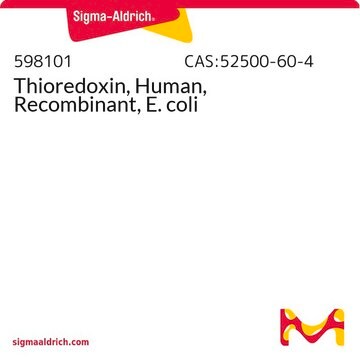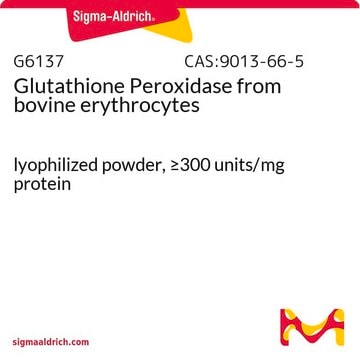T9698
Thioredoxin Reductase from rat liver
buffered aqueous glycerol solution, ≥100 units/mg protein (Bradford)
Synonym(s):
NADPH:Oxidised Thioredoxin Oxidoreductase, Thioredoxin: NADP+ Oxidoreductase
About This Item
Recommended Products
biological source
rat liver
Quality Level
Assay
≥90% (GE)
form
buffered aqueous glycerol solution
specific activity
≥100 units/mg protein (Bradford)
mol wt
55—67 kDa
technique(s)
activity assay: suitable
impurities
Glutathione reductase
solubility
water: soluble
suitability
suitable for molecular biology
UniProt accession no.
shipped in
dry ice
storage temp.
−20°C
Gene Information
rat ... Txnrd1(58819)
General description
Application
Biochem/physiol Actions
Unit Definition
Physical form
Storage Class Code
12 - Non Combustible Liquids
WGK
WGK 1
Flash Point(F)
Not applicable
Flash Point(C)
Not applicable
Personal Protective Equipment
Certificates of Analysis (COA)
Search for Certificates of Analysis (COA) by entering the products Lot/Batch Number. Lot and Batch Numbers can be found on a product’s label following the words ‘Lot’ or ‘Batch’.
Already Own This Product?
Find documentation for the products that you have recently purchased in the Document Library.
Customers Also Viewed
Articles
Cellular oxidative stress is countered by enzymatic scavengers and antioxidant modulators against reactive oxygen species damage.
Cellular oxidative stress is countered by enzymatic scavengers and antioxidant modulators against reactive oxygen species damage.
Cellular oxidative stress is countered by enzymatic scavengers and antioxidant modulators against reactive oxygen species damage.
Cellular oxidative stress is countered by enzymatic scavengers and antioxidant modulators against reactive oxygen species damage.
Our team of scientists has experience in all areas of research including Life Science, Material Science, Chemical Synthesis, Chromatography, Analytical and many others.
Contact Technical Service










